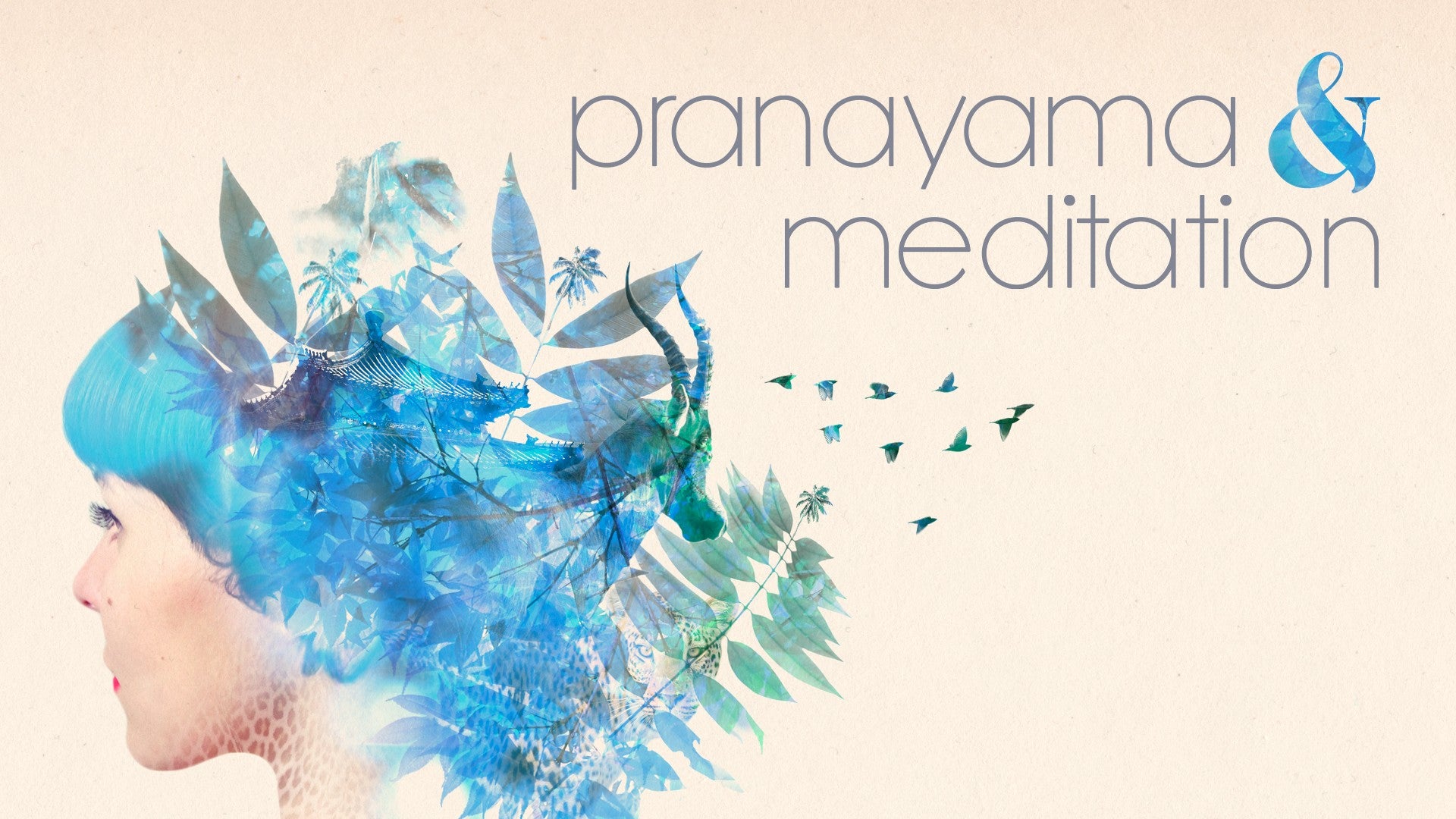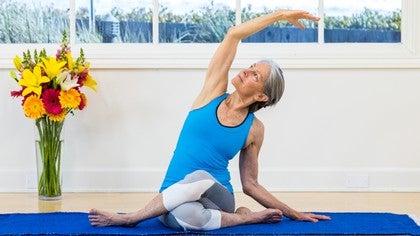Description
About This Video
Transcript
Read Full Transcript
Hi everybody, here we are again. We're working with reclining Supta Baddha Konasana, sometimes known as reclining bound angle. We're going to start with a bolster relaxation restorative and then go into the reclining Supta Baddha Konasana. So let's see, Satrine and Rosemary are going to do two different versions of this but they're very similar and the idea here is to get some breathing into the back body. So we'll have two blankets for Rosemary and just the bolster.
So you might like to have a lot of height when you're bringing your body down onto this, it's kind of a chest down, bolster twist. So hang on a moment before you go down and you might like to have more height and sometimes you'll start with a particular setup and you feel it's not quite comfortable and oh I need another blanket or I need to get rid of one. So feel free to adjust. You bring your hip up quite close to the edge of the bolster or the blankets and before you lie down you lift up, raise your belly up and your ribs and turn the body as you come down and turn your head as well so that you end up looking away from your knees. So go ahead and let's come to that part and we may readjust the positioning of your head and neck because we want you to be comfortable.
So sometimes it's perfectly comfortable to have your head and eyes turned away from the knees. It's a deeper twist and sometimes you might do that and it feels really good at first or not but if as a few seconds or a minute or so goes by it stops feeling so comfortable you might want to turn your head back in the other direction. So I'm going to ask Rosemary to turn her head back and she can take this blanket and make a little wrinkle on the backside and give herself a little slant to put her head on. So she's not only looking in the same direction as the knees. You can do this in such a way that your head doesn't have to turn as far.
You don't want to feel any strain with this turning of your neck and you can tell when it's right because your body just kind of goes into this big and you're happy and that's what we want here. So the first minute or so that you're down you may be making some adjustments and that's fine and you want to really just let yourself sink into the bolster, the blankets, scan your arms and hands. Sometimes it's helpful to turn the hands a little bit on the side or palms up so that you really can just let the fingers be limp and it allows the circulation of your life force, the prana, to flow more freely through the areas when they're not tense and it also allows your breath to move more easily because you're not tense. And within this first minute or so you'll start feeling that the breath smooths out, you've set up your prop, it takes a little while. Sometimes my students have said that they feel better with the top leg stretched out a little bit so that the thigh or the knee rests on the arch of the other foot.
So that's a variation that you can try and sometimes it actually helps the breathing pattern to be felt more in the organs and the low back. So we're starting structurally and setting up structure so that the structure can really let go and then you'll be able to tune into the more subtle layers of your existence. And I'm going to suggest that you try to find yourself at the end of an out breath and maybe just wait a few moments for, you could think of it as a wave, a gentle wave of the in breath, you feel it coming and then there's a moment where, okay, it's time to breathe in again. Sometimes it doesn't feel comfortable to pause after the exhalation and if that's the case for you, just keep your breathing cycle steady. You might notice that you feel more expansion into your low back and low rib area in this position and that's very soothing to the adrenals and the nervous system.
And again, that soothing quality allows the life force, the prana, to flow more thoroughly through areas where it might normally be blocked. And that just feels good. It might be wise to set a timer when you're in this position because you can fall asleep in it and I've noticed that somewhere between three and five minutes for me, closer to five, is a sweet spot where I get really relaxed but I don't end up feeling dull when I come up. So I almost never set the timer for three minutes anymore, I usually set it for five. Now you can experiment with not using a timer as well, just go by what feels right.
It's your practice and you want to make it your practice. So let your breathing just find its own pace now, finishing if you're in the middle of a cycle or something and then just allowing the breath to be and observing and resting deeply in these moments. As the input of activity decreases, your sensitivity to what's going on increases. Welcome that. Because part of what yoga is about is discovering the mystery of life.
And that mystery does not readily reveal itself if we're always busy. So, I encourage you now to just imagine that it's about time to change sides. To not get up immediately, just to put that thought into your system, take a deep breath or two and then bring your hands to an area that's near the shoulders or upper chest, place them down on your mat and exhale, push yourself back up and unwind. You can come to hands and knees and walk your knees over to the other side, bring your hips up close and sort of heave yourself up, yes, lift and begin the rotation and lay your belly down followed by the ribs and chest and again find out where your body is more comfortable and sometimes you have to be there for a few moments to really tell. That may include stretching one leg out, it may not.
There's always sort of tracing your awareness around the head and neck and your face and your tongue and jaw. When the sense organs are quiet, our sensitivity increases and making the hands soft, making sure you're not supporting yourself with your arms at all, let the device under you do all that and welcome the pull of Mother Nature in the form of gravity. So she pulls us down and in and we might as well just go with it for a while. Breathing adjusts and for a while we're going to encourage the breath to deepen, now a little more on the in-breath. Breathing and feeling what the expansion does, how it sort of pushes out into your ribs and your lower back and then releasing it slowly enough that you feel how the body then goes back into a more passive state.
So the in-breath is a more active state and I'm going to suggest that you try a couple of times maybe, taking that deeper in-breath, feeling the pressure inside the lungs and how the lungs sort of squeeze and hug the heart and the rib cage and pause your breath. I would say 85 to 90 percent full, not too full, but full enough to feel that inward pressure pressing out and before you breathe out, if you haven't already, another little sip of breath inward helps you to release the breath out more smoothly and then just let the breath flow a couple of times on its own, sort of it's a kind of a recovery breaths, being more acutely aware in the non-doing and then after this next exhalation you can take a deeper rib widening, chest expanding breath, 85 to 90 percent, not too full and again at the end suspend, retain for a little bit that fullness, just enjoy the fullness. A couple of seconds, five or six, just however many your body will let you take a sip in before you let it go and smoothly release and that might be enough of that activity for you, you might decide you want to do a third one and I'll just be quiet a little bit here so you can just either let the breath find its own pace, reveling in that or trying one more of those retentions with an almost full breath. Very attentive, kind, curious. And by now you're just in a resting phase.
Part of us is always looking for directions, just tell me what to do. If that comes up for you, just suggest to yourself that the breath carry you to wherever you need to be, let it carry you. Okay, so again putting the thought of transitioning into your system, give yourself, allow a deeper breath or two in preparation and then as you're ready you can put your hands near where your shoulders are or your chest, push yourself up, not leading from the head if you can possibly just kind of let it be more behind you instead of in front of you. Very nice and just for a moment you can sit on your heels or just sit cross-legged. The next thing that you're going to do is a straight out stretch on your bolster or blankets.
And I think we'll show two things and one we're going to show with Satrine is going to go into a wide knee child's pose and you want the bolster under your belly if possible and if it isn't high enough for that you could turn it on its side, okay, and you can always add more blankets so that you feel that when you come forward into this position that your belly as well as your chest are supported. You can have your head straight down, your nose into the bolster or turn your head to one side. Okay and we're going to have Rosemary lie over her bolster with her legs straight back and the pubic bone is going to be a little bit off the back edge which will allow the sacrum to drag down and kind of lengthen the lower back and although it may not look like the lower back is being lengthened you'll feel it when you let your pubic bone and pelvis come a little bit off the bolster and let's have the toes touching or pointing towards each other and then let the heels fall apart. So again just a minute or two here with no particular kind of breathing just allowing this symmetrical posture to help this force of life prana to flow through you, to fill every little crevice and feed every little cell. Okay.
And then, alas, you may say, or you may be ready to move, I'm going to encourage you to come back up in the same fashion, taking a breath or two first, and then to place your hands near the height of the shoulders, wherever it seems functionally useful for you to push from to bring your body back up to hands and knees. And actually, I was thinking to have you do something called cats and cows before we go into our Supta Baddha Konasana, and you can just come on to your hands and knees and do a few of those, where you're letting your head go down and rounding the spine upward towards the ceiling, yes, tailbone and forehead moving towards each other, and then keep your head down as you sink into your chest, allowing your shoulder blades to virtually collapse towards each other, and as they do that, your upper spine can sink way in, you can really relax your neck here, and then when you do bring your head up, try to keep this sinking in of the upper back, yes, it can feel much, it's less of a neck fold, more an extension of the spine, and then back into the rounded spine in the other direction. And let's just go ahead and do two more of those, keeping the head down as you transition into the cow position. If you look at this from the side, it almost looks like a grazing cow while the head is down, and then the head comes up, inhaling, and as you transition into exhale, turn the tailbone under, let your head drop, rounding the spine again, and then just come back into a neutral spine from there, very nice, and you're going to move your bolsters aside, we're going to fold two blankets for the Supta Baddha Konasana reclining bound angle position, and I'm going to take the blanket out from under me to show it, and we'll all three sort of do it together here. You unfold your blanket to, this is maybe three and a half feet long and more narrow this way, so you're going to hold it lengthwise and put down one edge of it, and then you're going to fold the blanket a third of the way across and then a third of the way back again.
Some people call this a fan fold, and if you just turn it over once, you can usually discover if there are any wrinkles, and I'd like you to fold two of them the same way, just like this, stack them on top of one another, if you have fringes on your blanket, have both fringes at the same end, and then you'll be lying the blankets lengthwise down with the fringed edge at the area where your head is going to be. And you can have that fringed edge all the way to the top of your mat and beyond, because really your spine, if you have a three and a half or four foot blanket, your top of your head will only be quite a ways away from the end, and that will be very useful because you're going to fold and sort of roll that for a little support for your head. But not at first. Okay, we've got the blanket set up. Now we need to get the blocks, two blocks either side, for the vada canasana support of the legs, and you're going to have a belt that you'll be wrapping around your lower ribs.
So my two students here, Citrine and Rosemary, are going to open out their belts and you're not going to hook the belt because you're going to be holding on to it with your arms. The place that you're putting the belt is just above your waist. So if you feel your hips and you feel that space where there's neither hip nor rib and you come up just a little bit, you're on the lower rib cage. So oftentimes we think of the rib cage as sort of ending here, but it goes down and towards the back. And I'd like you to be able to feel that lower end of the rib cage is where the ribs are a little freer to move.
And the exact placement of this will come a little easier once you're down. So you'll lie down with the belt and then you can adjust and that's it. Be very careful not to create any wrinkles at the tail end of your blanket. And when you lie down and you place your blocks and you get your belt around your ribs, you're going to cross the belt in front of your body. So if you're setting this up at home, you might want to just watch a little bit until we get them all settled and then you can get yourself down there or part way down and watch.
And you take the belt in your hands with the palms facing up and the thumbs turned out and your hands are close together to begin with. And then you slide your hands outward on the belt until they're open. And that weight, they're going to be close to a foot off the floor, maybe 10 to 12 inches off the floor of the hands. And that weight gives you sensation all the way around the circumference of your ribs. And that's what you're going to be attending to here.
It should not feel that it doesn't permit you to breathe in as deeply as you want to. So if it does, maybe have the hands closer to the ribs. And the elbows are a little bit away from your rib cage. You don't want them real close into the rib cage, they're away. So you're settling in and we're going to do a few breaths here and then we'll raise the head up.
So first settling and exhaling and just as you're taking your in-breath in, notice what it feels like to have that little bit of pressure around your lower rib cage. Don't try to do anything about it to begin with, just feel the breath come into the belly and then into the ribs and then let it out. So we're working, we've got all this attention to structure, which allows you to then leave the structure behind as you go deeply into the sensations of these movements, of these breath practices. Yeah, sometimes it's nice to, I just heard one of these students here sigh on the out-breath, sometimes it's really nice to take in a breath and just... And now what I'd like you to do as you're breathing in is to not breathe as much into the belly as you might be right now, but to slightly hold back at the lower belly, just slightly, and instead give your breath out into the belt, especially laterally, breathing to the sides and you might even feel the hands being pulled up a little bit as the ribs expand.
And then as you gradually let go of your breathing, you might feel the hands fall a little bit more towards the ground. It's subtle, but it's happening. So gently, some of the breath's being shorter, some of the breath's perhaps being longer. Let go of your breath from the belly, breathe in to the side ribs and the back ribs. This is an opportunity to feel the full circumference.
Where do you breathe into more easily? And where maybe are you not breathing? What's open? What's not open? And you're not making a list to answer these questions. You're just exploring with this deep sense of curiosity.
What I see and what I've experienced is that getting these lower ribs to spread laterally and to feel some of the breath touching the back body, remains or brings along the rest of the ribcage to also more fully receive the in-breath, to open to it and to more fully let go. And now I'm going to suggest that you, at the end of this next breath, let go of the belt momentarily and you can reach back to the blankets over your head and find the very end of the blanket, if you can, and roll it under. So you're rolling it under in such a way that it makes a nice little roll to put your skull on and then take your hands to the area underneath your neck and you can lift your head and extend, lengthen the back of your neck. And if your neck wants to have some support of the blanket, you can pull the blanket upward towards your neck a little bit. If your neck would rather be free of support, you can push the blanket down a little bit with your fingers and have the blanket more under your skull than the neck.
Now these are subtleties that you might not think of, but I'm bringing it to your awareness because you can make a huge difference. So now I'd like you to move the belt up higher so that the back of the belt is right at the bottom of your scapula, your shoulder blades, and then find out where the front part of the belt wants to come. It may want to come and cross your body right under your breast line. It might want to come a little bit above. And then it's the same thing, you take a hold of the belt and holding the belt, slide your hands out until you feel a definite but comfortable pressure on your chest and the hands will still be off the ground.
And now with this breathing, because you've raised your skull with comparison to your chin, you're going to be able to keep that softness in the brain and the eyes so that your in-breath can come in and not disturb the sympathetic nervous system and cause you to get excited, but to allow you to become passive enough to experience this. So here they go, they're breathing deeper into the upper chest but not first, that comes, you could say third, fill into the lower rib cage, feel the breath come into the middle rib cage and then feel it come up and caress the belt and then let the belly release the breath, the lower and middle rib cages release the breath and then finally this part where you have the belt, release the breath. And don't drag it out too long, make it a comfortable pace for yourself and keep reminding yourself to pour this mind-brain complex down towards the heart. It's like having devotion, it's a devotional, it's a love story. So gently, deeply in and you could even, once you've gotten the breath up into that upper chest area, you could find out what it's like to suspend breathing for a few moments, to retain that fullness.
If your body wants to let go of the breath right away, do so. Maybe that will feel really good to you to stay there. And when you're ready to let go of the breath, take in a sip of breath, not much. That allows you to breathe out more slowly. Take a resting breath or two and then you can bring that kind of breathing in again, bringing the breath up in stages, not really stopping the breath but feeling the different parts from bottom to top expanding.
It starts to be almost like you don't have a rib cage, that there's just this, everything becomes so porous that it's just coming in and then you kind of spend a little time drinking it in once it's full, once you're full. It should feel comfortable, calming, releasing at your own pace. You may very well have released long ago. Resting breath. And then give yourself another one of those with or without the pause.
And it may be time just to let the belt go. If you're in the middle of a breath, expanding into the belts, finish this one. If you're not doing that anymore, just let the belt go and let your arms come down towards the floor and relax, palms facing up, feeling into the after effect. And I'm going to suggest that you stretch your legs out if they're still in bada konasana. You can turn the thighs inward a little bit when you first stretch them out and then let them go.
So let your breath move in more deeply, gently, preparing to exit this posture. The first thing you're going to do is reach back and take the roll out of the blanket under your head. Yes, and then you might want to release the belt so you don't get tangled in the belt. And then bend one knee and then the other, and you'll roll over to your right. Support your head either with the blanket or your arm as you roll to the side.
Since you're on your right, after one more breath, use your left hand to push yourself up, letting your head come up last. So this would be the perfect moment, of course, to just sit quietly for a while or to take this practice of breathing in and sitting into the pause after in-breath, and feel free to do that right now as we close this particular session. Thank you for your practice. Thank you. Namaste.
Pranayama & Meditation: Patricia Sullivan
Comments
You need to be a subscriber to post a comment.
Please Log In or Create an Account to start your free trial.













